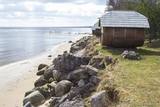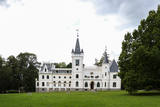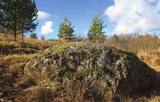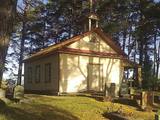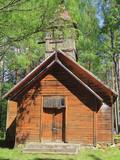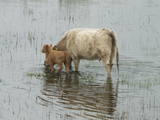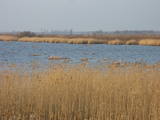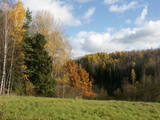| Нo | Название | Описание |
|---|---|---|
|
Старинный ливский поселок, ливское название которого Mustanumm. Еще в середине 20-го века здесь жили ливы. В поселке Мелнсилс у впадения речки Бакупите в Рижский залив представители семейств Ландманисов, Морицов и Отомеров построили три парусника. В поселке находятся два культурно-исторических места: церковная гора Бакю – древнее культовое место и городище пирата Троммеля. (Источник: Ройский ТИЦ) |
||
|
Построен в первой половине 19 века, в стиле неоготики Тюдоров. Первым владельцем замка стал барон Иоанн Готлиб фон Вольф. В 70 – 80 годах того же века его перестроили в стиле французского неоренессанса. Во время революции 1905-го годa замок сожгли, однако восстановили, введя в его облик формы модерна. Замок можно осмотреть изнутри, предлагаются экскурсии. |
||
|
In Estonian, Luitemaa means ‘the land of dunes’. It is the seashore territory of the Gulf of Pärnu, 13 km between Vöiste and Häädemeeste with shallow waters, vast coastal meadows, the highest dune range in Estonia and the Tolkuse Mire (Tolkuse raba). The Tolkuse mire trail (~2.2 km) and watching tower are available for dune and mire sightseeing tours. Situated in Luitemaa Nature Reserve. |
||
|
This is a highland swamp with several little lakes. At the SE of the area is a wooden trail.
|
||
|
This is the thickest English oak (Quercus robur) in Lithuania, with a circumference of 9.4 m (as opposed to the Kaive oak in Latvia, which has a circumference of 10.18 m).
|
||
|
Камень “Cлед коня” с вмятиной, напоминающей отпечаток
следа коня.
|
||
|
Хозяйство занимается разведением чистопородного и гибридного крупного рогатого скота на племя, откорм и мясо, продажей молочных поросят и производством свинины, выращиванием зерновых и пищевого картофеля, а также пчеловодством. Хозяева уже несколько лет в шести прудах хозяйства разводят карпов, линей и орф. В зимний сезон рыбу можно ловить в специальных бассейнах, которые были созданы, затопив излучину русла реки Берзене. Крестьянское хозяйство «Валти» своим посетителям предлагает обучение по вопросам ведения биологического хозяйства, разведения крупного рогатого скота мясной породы, в том числе генетической работы по поддержанию чистоты породы и рыбалку на свежем воздухе. Для семинаров и учебы в помещении, где разводят рыб, был обустроен специальный зал для семинаров и кухня. В территории хозяйства находится и содержится тропа Оскара Калпака, которая пересекает территорию, интересную с геологической и ландшафтной точки зрения. |
||
|
Pajumäe ‒ это маленькое симпатичное биологическое хозяйство, которое находится в зеленом регионе Мульгимаа и производит различные молочные продукты. Здесь Вы сможете увидеть все этапы производства молока ‒ от выпаса коров на пастбище до обработки сырья на молочном заводе. |
||
|
The Forest Trail follows small roads and trails through the woods. Along the route you will see the Ērģeļu Cliffs, where the observation terrace provides a great view of the impressive 700 m wide sandstone cliff and the beautiful natural landscape in the ancient River Gauja valley. One of the most beautiful places on the banks of the River Gauja is at “Caunītes” tourist lodging, where you will end the first day of the route. Further on the trail leads through pine forests and wetlands, across and around hills and slopes. One of the most beautiful views of the River Gauja opens from Sietiņiezis Rock, a 15 m high sandstone cliff where a circular 1.5 km trail has been constructed. Coming to Valmiera, you will reach the so-called “Dzelzītis” bridge (a narrow-gauge railway bridge) and continue walking along the River Gauja to Valmiera Centre. Sites of interest in Valmiera: St. Simon’s Church, ruins of the Livonian Castle and Valmiera Museum. There is also an adventure park “Sajūtu Parks” (“Park of Senses”), where you can walk on the barefoot trail, the tree-top trail and enjoy other activities. |
||
|
From the Markova castle hill, which you will access from the local information trial, you will see a view of the Daugavsargi curve of the Daugava. Further along, you will reach the open shore of the Daugava to see one of the most unique landscapes of Latvia’s river valleys. The Slutišķi village of Old Believers and the mighty Slutišķi cliff will be in the background.
|
||
|
Иденская часовня, посвящённая во славу Святого Креста,
построена в 1898 году на средства декана Ф. Смилгевича. Здесь
проводятся католические богослужения. Это деревянное здание
в форме одной комнаты и с небольшой колокольней. Особый
праздник часовни проводится 17 сентября, в День стигматов, и посвящен св. Франциску Ассизскому.
Часовня используется и как каплица.
|
||
|
Моленная Крупенишкской старообрядческой общины построена в
1908 году. Автор проекта храма инженер И. Иванов. В теперешнее время
храм в плохом техническом состоянии.
|
||
|
The shallow and mostly overgrown (65% of its surface) Lake Engure is one of those Latvian lakes which are most favoured by birds. It is a location which is governed by the Ramsar Convention on Wetlands, and 186 species of nesting birds have been identified there. The area is also distinguished by great botanical diversity (more than 800 kinds of plants). The coastline varies between sandy beaches and seashore meadows. There are forests, fishing villages and damp areas which ensure a great diversity in landscapes and species. The flood-land plains of the lake and the sea are grazing grounds for wild livestock – horses, blue cows, etc. Several bird-watching towers are open to visitors, as is the Orchid trail. The Centre for Ornithological Research is located on the eastern bank of Lake Engure. A unique floating house built by ornithologists is located on the lake. The territory is appropriate not just for holiday-makers, but also for hikers, bicyclists and bird-watchers. A leisure area and a small exhibition are located close to the ornithological research centre. |
||
|
A shallow, eutrophic (more than 60% coverage), lagoon-type lake, which is a restricted area to protect the overgrowing lake and the damp meadows which surround it. There are some 60 species of nesting birds in the area. The system of dams on the southern shore of the lake can be used by visitors to look at the area.
|
||
|
Dodieties ekskursijā, lai gūtu ieskatu lauku profesijā un dzīvesveidā, kā arī iegūtu jaunus iespaidus un labu atpūtu visai klasei. Ekskursijas sākumā apmeklējiet savvaļas dzīvnieku parku, kura voljēros dzīvo ~ 200 dambriežu. Tālāk dodieties uz saimniecību, kur aug vairāk nekā 100 augu sugu un šķirņu - ekskursija pa saimniecību, augu stādu iegāde, tēju, augļu un ogu degustācijas. Pēc tam apmeklējiet Skrīveru pārtikas kombinātu, kurā iespējams iegādāties gardās Gotiņkonfektes un doties ekskursijā. Brauciena noslēgumā - Skrīveru mājas saldējums ar stāstījumu par saldējuma gatavošanu un degustāciju. |
||
|
Das Naturreservat Krustkalni wurde 1977 geschaffen. Die Vielfalt der Pflanzen in der Region basiert sowohl auf dem Terrain – dem Madona - Damm, einer Reihe von Hügeln mit Geländesenken dazwischen, Sümpfen und kleinen Seen – als auch auf dem Biotop – natürlichen Wiesen, Waldlichtungen, Stellen, wo unterirdische Bäche an die Oberfläche sprudeln und riesigen Waldgebieten mit sehr alten Baumbeständen. Mehr als 800 Pflanzenarten wurden im Reservat bestimmt. Das Reservat darf nur in Begleitung eines Führers von der Reservatsverwaltung durchquert werden, wofür man sich vorher anmelden muß. Besucher können die Krāku - Quelle, den See Svēte-Dreimaņi und andere Stätten besuchen.
|
||
|
Das Handwerkshaus Heltermaa ist ein Laden mit lokalen Lebensmittel und Handwerkserzeugnisse von Hiiumaa, der während der Sommersaison geöffnet ist. Die Auswahl ist sehr groß: von Keramikgeschirr bis hin zu Limonaden von Hiiumaa. |
||
|
Das Wirtshaus befindet sich am Rande der Straße Murjani – Valka (A3) und man kann es dank dem Gebäude und den Märchenfiguren leicht erkennen, die sich auf dem Hof des Wirtshauses aufgestellt sind. Lettische Küche: Suppen (kalte Rote-Beete-Suppe, Bohnen-, Sauerkraut-, Ampfersuppe), gebratener Schweineschenkel, Blutwürste, Schweinrippen, Beerenkompott mit gerösteten Haferflocken, geschichtetes Roggenbrot-Dessert. Das besondere Gericht: Die feurige Suppe von Raganas ķēķis (Übers.: Hexenküche). |
||
|
The cafe Picerija is situated in Lielvarde alongside Riga-Daugavpils highway. |
||
|
This is the only viewing platform of its kind. It is north of Pāvilosta, between the sea and Latvia’s largest gray dune. The second level of the platform offers a good view of the habitats which surround the dune, as well as the seashore and the largest seashore rock on the shores of the Baltic Sea – the Pāvilosta sea rock. You can also see the northern part of Pāvilosta. When it is windy outside, you’ll see kiteboard riders showing their tricks.
|
||
